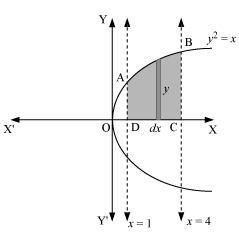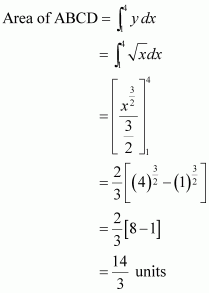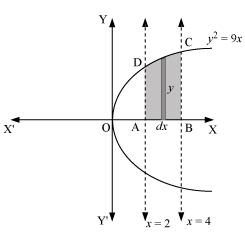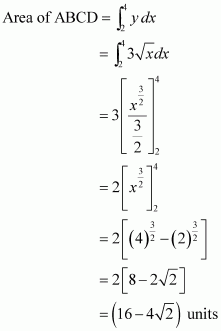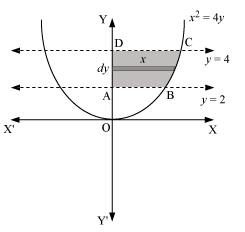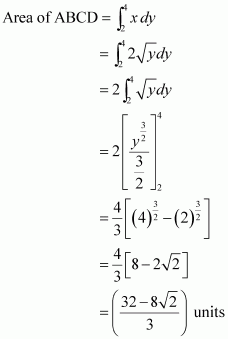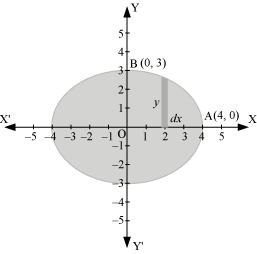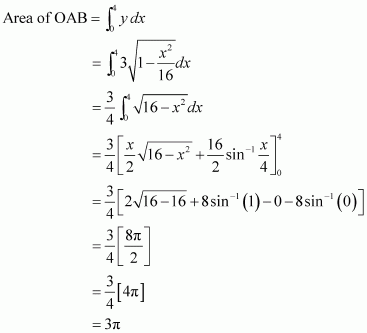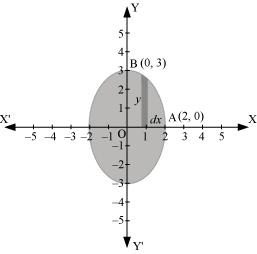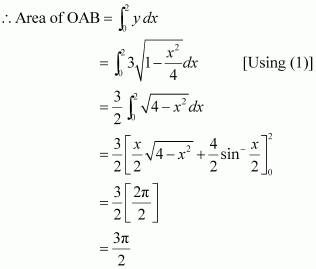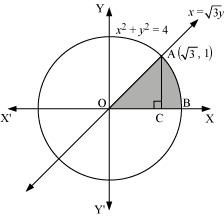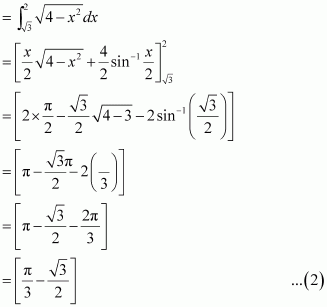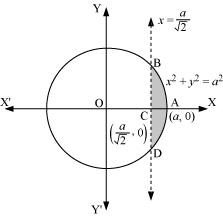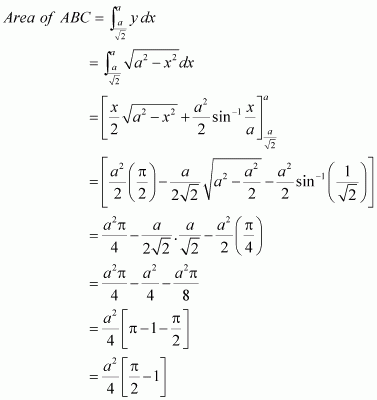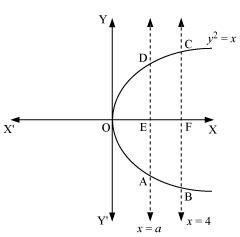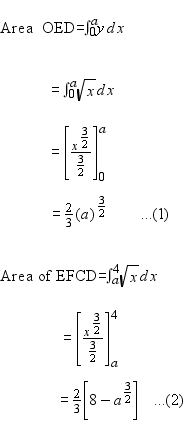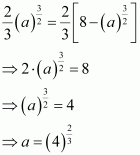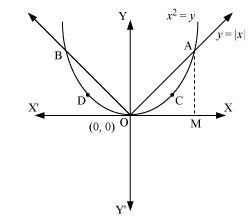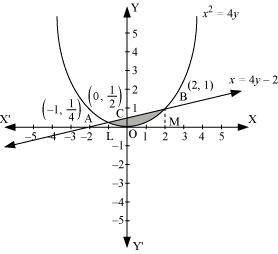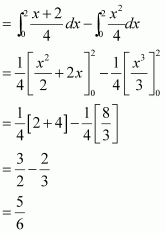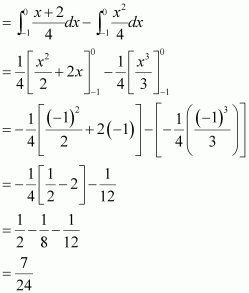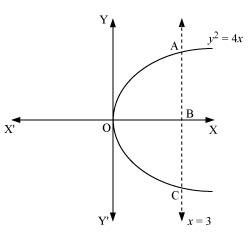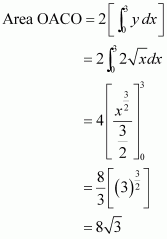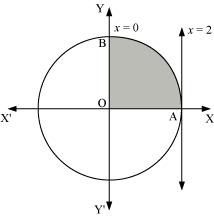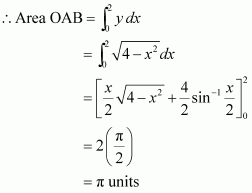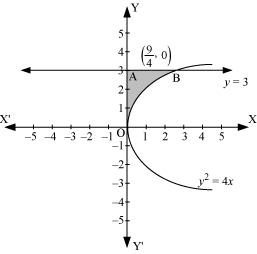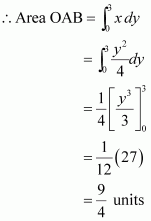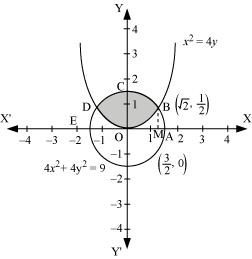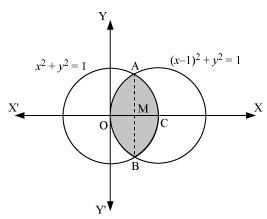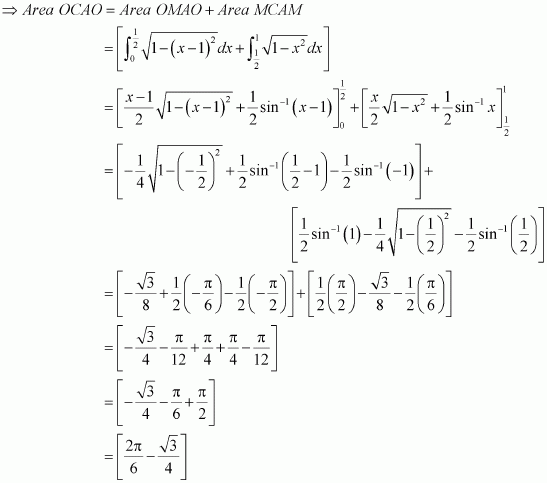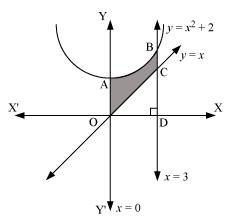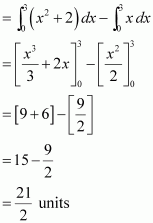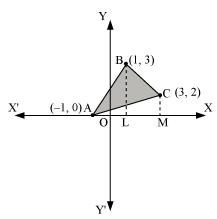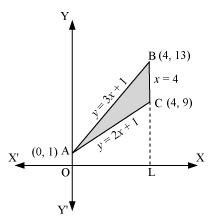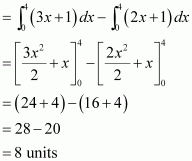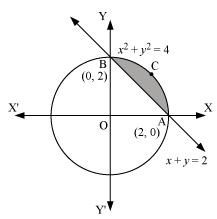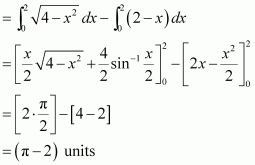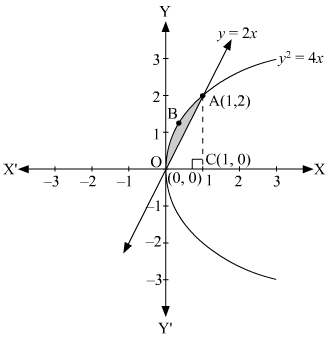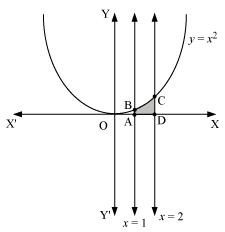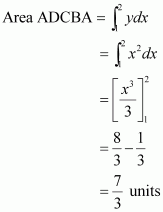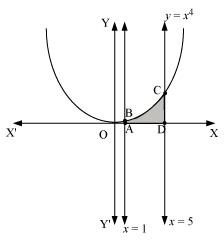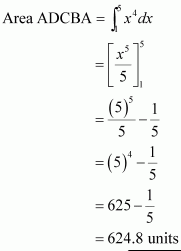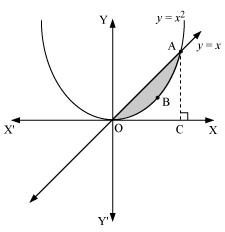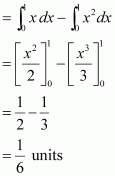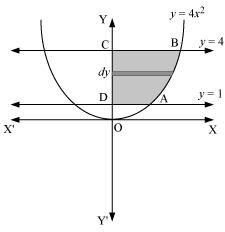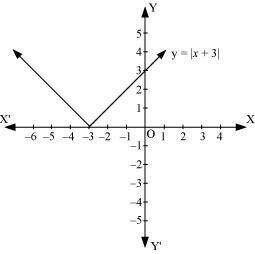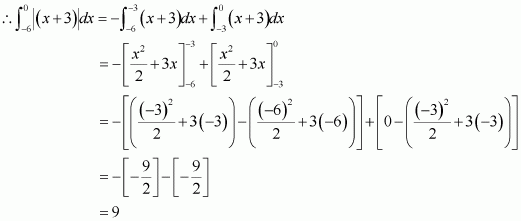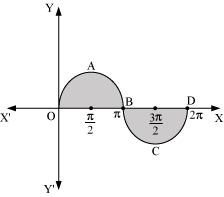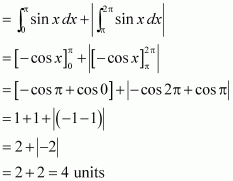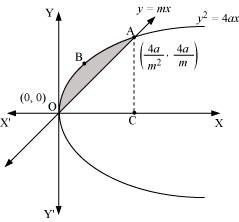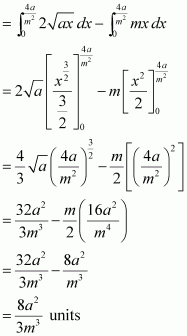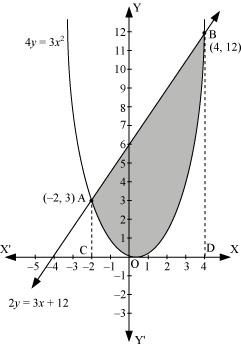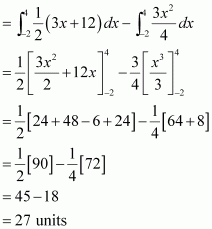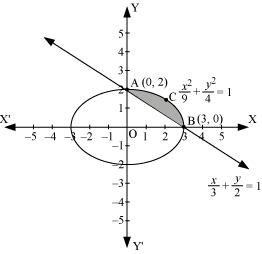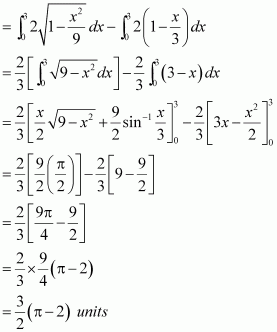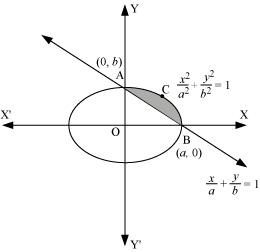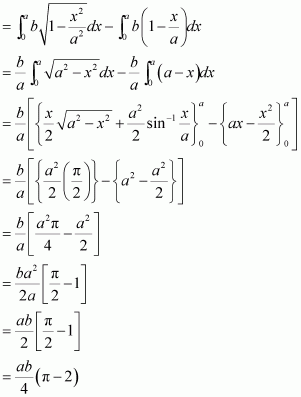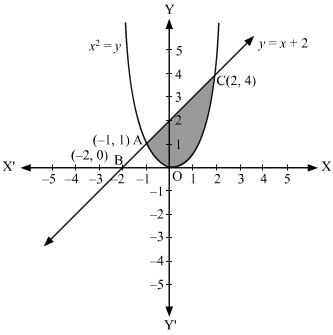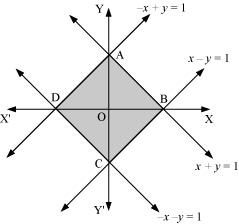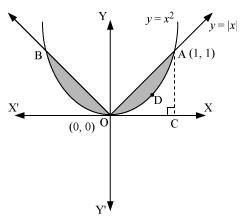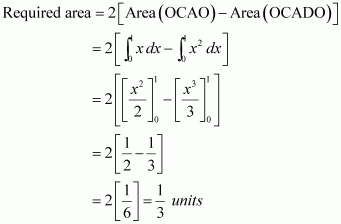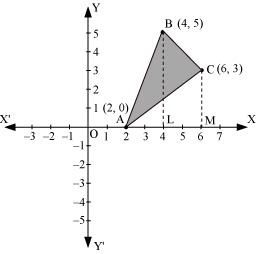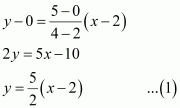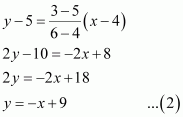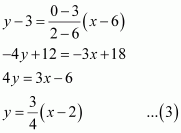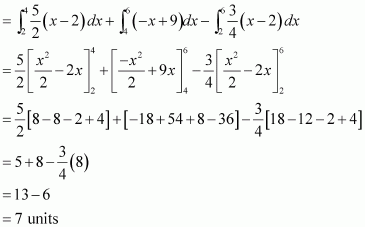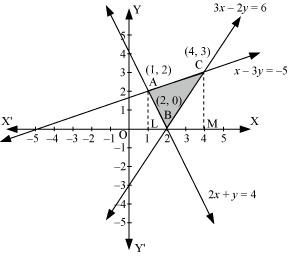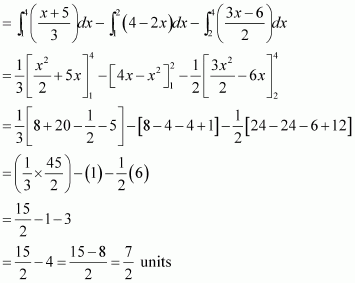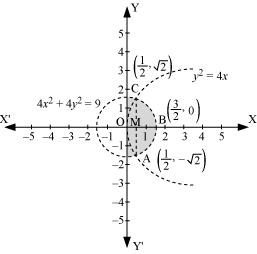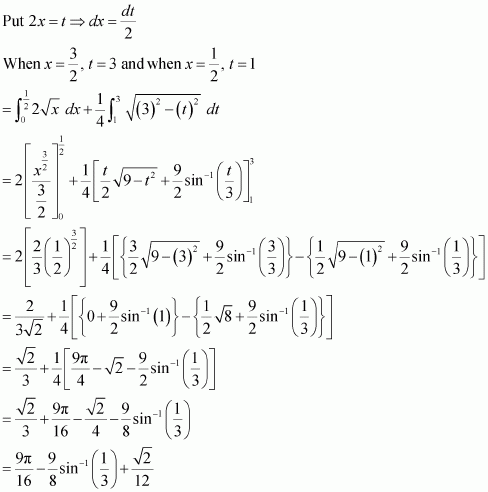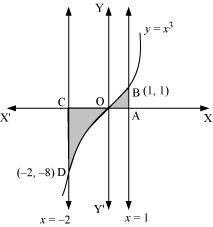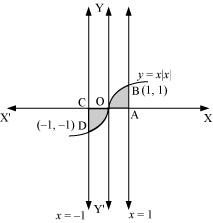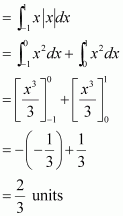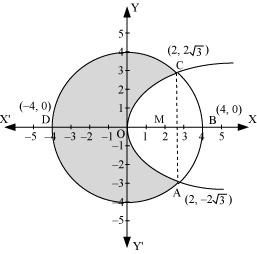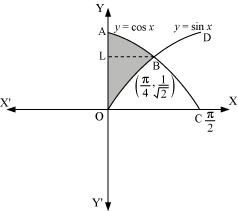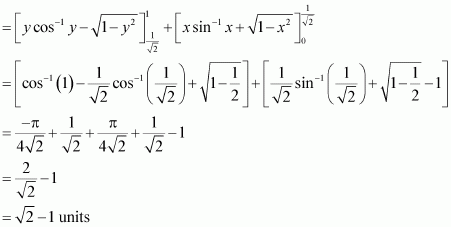Page No 365:
Question 1:
Find the area of the region bounded by the curve y2 = x and the lines x = 1, x = 4 and the x-axis.
Answer:
The area of the region bounded by the curve, y2 = x, the lines, x = 1 and x = 4, and the x-axis is the area ABCD.
Question 2:
Find the area of the region bounded by y2 = 9x, x = 2, x = 4 and the x-axis in the first quadrant.
Answer:
The area of the region bounded by the curve, y2 = 9x, x = 2, and x = 4, and the x-axis is the area ABCD.
Page No 366:
Question 3:
Find the area of the region bounded by x2 = 4y, y = 2, y = 4 and the y-axis in the first quadrant.
Answer:
The area of the region bounded by the curve, x2 = 4y, y = 2, and y = 4, and the y-axis is the area ABCD.
Question 4:
Find the area of the region bounded by the ellipse
Answer:
The given equation of the ellipse, , can be represented as
It can be observed that the ellipse is symmetrical about x-axis and y-axis.
∴ Area bounded by ellipse = 4 × Area of OAB
Therefore, area bounded by the ellipse = 4 × 3π = 12π units
Question 5:
Find the area of the region bounded by the ellipse
Answer:
The given equation of the ellipse can be represented as
It can be observed that the ellipse is symmetrical about x-axis and y-axis.
∴ Area bounded by ellipse = 4 × Area OAB
Therefore, area bounded by the ellipse =
Question 6:
Find the area of the region in the first quadrant enclosed by x-axis, line and the circle
Answer:
The area of the region bounded by the circle, , and the x-axis is the area OAB.
The point of intersection of the line and the circle in the first quadrant is .
Area OAB = Area ΔOCA + Area ACB
Area of OAC
Area of ABC
Therefore, required area enclosed =
32 + π3 – 32 = π3 square units
Question 7:
Find the area of the smaller part of the circle x2 + y2 = a2 cut off by the line
Answer:
The area of the smaller part of the circle, x2 + y2 = a2, cut off by the line, , is the area ABCDA.
It can be observed that the area ABCD is symmetrical about x-axis.
∴ Area ABCD = 2 × Area ABC
Therefore, the area of smaller part of the circle, x2 + y2 = a2, cut off by the line, , is
units.
Question 8:
The area between x = y2 and x = 4 is divided into two equal parts by the line x = a, find the value of a.
Answer:
The line, x = a, divides the area bounded by the parabola and x = 4 into two equal parts.
∴ Area OAD = Area ABCD
It can be observed that the given area is symmetrical about x-axis.
⇒ Area OED = Area EFCD
From (1) and (2), we obtain
Therefore, the value of a is .
Question 9:
Find the area of the region bounded by the parabola y = x2 and
Answer:
The area bounded by the parabola, x2 = y, and the line, , can be represented as
The given area is symmetrical about y-axis.
∴ Area OACO = Area ODBO
The point of intersection of parabola, x2 = y, and line, y = x, is A (1, 1).
Area of OACO = Area ΔOAM – Area OMACO
Area of ΔOAM
Area of OMACO
⇒ Area of OACO = Area of ΔOAM – Area of OMACO
Therefore, required area = units
Question 10:
Find the area bounded by the curve x2 = 4y and the line x = 4y – 2
Answer:
The area bounded by the curve, x2 = 4y, and line, x = 4y – 2, is represented by the shaded area OBAO.
Let A and B be the points of intersection of the line and parabola.
Coordinates of point .
Coordinates of point B are (2, 1).
We draw AL and BM perpendicular to x-axis.
It can be observed that,
Area OBAO = Area OBCO + Area OACO … (1)
Then, Area OBCO = Area OMBC – Area OMBO
Similarly, Area OACO = Area OLAC – Area OLAO
Therefore, required area =
Question 11:
Find the area of the region bounded by the curve y2 = 4x and the line x = 3
Answer:
The region bounded by the parabola, y2 = 4x, and the line, x = 3, is the area OACO.
The area OACO is symmetrical about x-axis.
∴ Area of OACO = 2 (Area of OAB)
Therefore, the required area is units.
Question 12:
Area lying in the first quadrant and bounded by the circle x2 + y2 = 4 and the lines x = 0 and x = 2 is
A. π
B.
C.
D.
Answer:
The area bounded by the circle and the lines, x = 0 and x = 2, in the first quadrant is represented as
Thus, the correct answer is A.
Question 13:
Area of the region bounded by the curve y2 = 4x, y-axis and the line y = 3 is
A. 2
B.
C.
D.
Answer:
The area bounded by the curve, y2 = 4x, y-axis, and y = 3 is represented as
Thus, the correct answer is B.
Page No 371:
Question 1:
Find the area of the circle 4x2 + 4y2 = 9 which is interior to the parabola x2 = 4y
Answer:
The required area is represented by the shaded area OBCDO.
Solving the given equation of circle, 4x2 + 4y2 = 9, and parabola, x2 = 4y, we obtain the point of intersection as.
It can be observed that the required area is symmetrical about y-axis.
∴ Area OBCDO = 2 × Area OBCO
We draw BM perpendicular to OA.
Therefore, the coordinates of M are.
Therefore, Area OBCO = Area OMBCO – Area OMBO
=∫02(9-4×2)4dx-∫02x24dx
=∫02322-x2dx-14∫02x2dx
=x2322-x2+98sin-12×302-14×3302
=24+98sin-1223-11223
=122+98sin-1223-132
=162+98sin-1223
=1226+94sin-1223Therefore, the required area OBCDO is 
Question 2:
Find the area bounded by curves (x – 1)2 + y2 = 1 and x2 + y 2 = 1
Answer:
The area bounded by the curves, (x – 1)2 + y2 = 1 and x2 + y 2 = 1, is represented by the shaded area as
On solving the equations, (x – 1)2 + y2 = 1 and x2 + y 2 = 1, we obtain the point of intersection as A

It can be observed that the required area is symmetrical about x-axis.
∴ Area OBCAO = 2 × Area OCAO
We join AB, which intersects OC at M, such that AM is perpendicular to OC.
The coordinates of M are .
Therefore, required area OBCAO = 
Question 3:
Find the area of the region bounded by the curves y = x2 + 2, y = x, x = 0 and x = 3
Answer:
The area bounded by the curves, y = x2 + 2, y = x, x = 0, and x = 3, is represented by the shaded area OCBAO as
Then, Area OCBAO = Area ODBAO – Area ODCO
Question 4:
Using integration finds the area of the region bounded by the triangle whose vertices are (–1, 0), (1, 3) and (3, 2).
Answer:
BL and CM are drawn perpendicular to x-axis.
It can be observed in the following figure that,
Area (ΔACB) = Area (ALBA) + Area (BLMCB) – Area (AMCA) … (1)
Equation of line segment AB is
Equation of line segment BC is
Equation of line segment AC is
Therefore, from equation (1), we obtain
Area (ΔABC) = (3 + 5 – 4) = 4 units
Question 5:
Using integration find the area of the triangular region whose sides have the equations y = 2x +1, y = 3x + 1 and x = 4.
Answer:
The equations of sides of the triangle are y = 2x +1, y = 3x + 1, and x = 4.
On solving these equations, we obtain the vertices of triangle as A(0, 1), B(4, 13), and C (4, 9).
It can be observed that,
Area (ΔACB) = Area (OLBAO) –Area (OLCAO)
Page No 372:
Question 6:
Smaller area enclosed by the circle x2 + y2 = 4 and the line x + y = 2 is
A. 2 (π – 2)
B. π – 2
C. 2π – 1
D. 2 (π + 2)
Answer:
The smaller area enclosed by the circle, x2 + y2 = 4, and the line, x + y = 2, is represented by the shaded area ACBA as
It can be observed that,
Area ACBA = Area OACBO – Area (ΔOAB)
Thus, the correct answer is B.
Question 7:
Area lying between the curve y2 = 4x and y = 2x is
A.
B.
C.
D.
Answer:
The area lying between the curve, y2 = 4x and y = 2x, is represented by the shaded area OBAO as
The points of intersection of these curves are O (0, 0) and A (1, 2).
We draw AC perpendicular to x-axis such that the coordinates of C are (1, 0).
∴ Area OBAO = Area (OCABO) – Area (ΔOCA)

square units
Thus, the correct answer is B.
Page No 375:
Question 1:
Find the area under the given curves and given lines:
(i) y = x2, x = 1, x = 2 and x-axis
(ii) y = x4, x = 1, x = 5 and x –axis
Answer:
- The required area is represented by the shaded area ADCBA as
- The required area is represented by the shaded area ADCBA as
Question 2:
Find the area between the curves y = x and y = x2
Answer:
The required area is represented by the shaded area OBAO as
The points of intersection of the curves, y = x and y = x2, is A (1, 1).
We draw AC perpendicular to x-axis.
∴ Area (OBAO) = Area (ΔOCA) – Area (OCABO) … (1)
Question 3:
Find the area of the region lying in the first quadrant and bounded by y = 4x2, x = 0, y = 1 and y = 4
Answer:
The area in the first quadrant bounded by y = 4x2, x = 0, y = 1, and y = 4 is represented by the shaded area ABCDA as
Area of ABCDA = ∫14 x dy =∫14 y2 dy as, y = 4×2 =12∫14y dy =12×23y3/214 =1343/2 – 13/2 =138 – 1 =13×7 =73 square units
Question 4:
Sketch the graph of and evaluate
Answer:
The given equation is
The corresponding values of x and y are given in the following table.
| x | – 6 | – 5 | – 4 | – 3 | – 2 | – 1 | |
| y | 3 | 2 | 1 | 1 | 2 | 3 |
On plotting these points, we obtain the graph of as follows.
It is known that,
Question 5:
Find the area bounded by the curve y = sin x between x = 0 and x = 2π
Answer:
The graph of y = sin x can be drawn as
∴ Required area = Area OABO + Area BCDB
Question 6:
Find the area enclosed between the parabola y2 = 4ax and the line y = mx
Answer:
The area enclosed between the parabola, y2 = 4ax, and the line, y = mx, is represented by the shaded area OABO as
The points of intersection of both the curves are (0, 0) and .
We draw AC perpendicular to x-axis.
∴ Area OABO = Area OCABO – Area (ΔOCA)
Question 7:
Find the area enclosed by the parabola 4y = 3x2 and the line 2y = 3x + 12
Answer:
The area enclosed between the parabola, 4y = 3x2, and the line, 2y = 3x + 12, is represented by the shaded area OBAO as
The points of intersection of the given curves are A (–2, 3) and (4, 12).
We draw AC and BD perpendicular to x-axis.
∴ Area OBAO = Area CDBA – (Area ODBO + Area OACO)
Question 8:
Find the area of the smaller region bounded by the ellipse and the line
Answer:
The area of the smaller region bounded by the ellipse, , and the line,
, is represented by the shaded region BCAB as
∴ Area BCAB = Area (OBCAO) – Area (OBAO)
Question 9:
Find the area of the smaller region bounded by the ellipse and the line
Answer:
The area of the smaller region bounded by the ellipse, , and the line,
, is represented by the shaded region BCAB as
∴ Area BCAB = Area (OBCAO) – Area (OBAO)
Question 10:
Find the area of the region enclosed by the parabola x2 = y, the line y = x + 2 and x-axis
Answer:
The area of the region enclosed by the parabola, x2 = y, the line, y = x + 2, and x-axis is represented by the shaded region OACO as
The point of intersection of the parabola, x2 = y, and the line, y = x + 2, is A (–1, 1) and C(2, 4).
Area of OACO = ∫-12x + 2 dx – ∫-12 x2 dx⇒Area of OACO = x22 + 2x-12 – 13×3-12⇒Area of OACO = 222+22 – -122+2-1 – 1323 – -13⇒Area of OACO = 2 + 4 – 12-2 – 138 + 1⇒Area of OACO = 6 + 32 – 3⇒Area of OACO = 3 + 32 = 92 square units
Question 11:
Using the method of integration find the area bounded by the curve
[Hint: the required region is bounded by lines x + y = 1, x – y = 1, – x + y = 1 and – x – y = 11]
Answer:
The area bounded by the curve, , is represented by the shaded region ADCB as
The curve intersects the axes at points A (0, 1), B (1, 0), C (0, –1), and D (–1, 0).
It can be observed that the given curve is symmetrical about x-axis and y-axis.
∴ Area ADCB = 4 × Area OBAO
Page No 376:
Question 12:
Find the area bounded by curves
Answer:
The area bounded by the curves, , is represented by the shaded region as
It can be observed that the required area is symmetrical about y-axis.
Question 13:
Using the method of integration find the area of the triangle ABC, coordinates of whose vertices are A (2, 0), B (4, 5) and C (6, 3)
Answer:
The vertices of ΔABC are A (2, 0), B (4, 5), and C (6, 3).
Equation of line segment AB is
Equation of line segment BC is
Equation of line segment CA is
Area (ΔABC) = Area (ABLA) + Area (BLMCB) – Area (ACMA)
Question 14:
Using the method of integration find the area of the region bounded by lines:
2x + y = 4, 3x – 2y = 6 and x – 3y + 5 = 0
Answer:
The given equations of lines are
2x + y = 4 … (1)
3x – 2y = 6 … (2)
And, x – 3y + 5 = 0 … (3)
The area of the region bounded by the lines is the area of ΔABC. AL and CM are the perpendiculars on x-axis.
Area (ΔABC) = Area (ALMCA) – Area (ALB) – Area (CMB)
Question 15:
Find the area of the region
Answer:
The area bounded by the curves, , is represented as
The points of intersection of both the curves are.
The required area is given by OABCO.
It can be observed that area OABCO is symmetrical about x-axis.
∴ Area OABCO = 2 × Area OBC
Area OBCO = Area OMC + Area MBC
Therefore, the required area is 
Question 16:
Area bounded by the curve y = x3, the x-axis and the ordinates x = –2 and x = 1 is
A. – 9
B.
C.
D.
Answer:
Required Area =
∫-2 0ydx+∫01ydx
=∫-2 0x3dx+∫01x3dx=x44-20+x4401=0-164+14-0=-4+14=4+14=174 sq. unitsThus, the correct answer is D.
Question 17:
The area bounded by the curve, x-axis and the ordinates x = –1 and x = 1 is given by
[Hint: y = x2 if x > 0 and y = –x2 if x < 0]
A. 0
B.
C.
D.
Answer:
Thus, the correct answer is C.
Question 18:
The area of the circle x2 + y2 = 16 exterior to the parabola y2 = 6x is
A.
B.
C.
D.
Answer:
The given equations are
x2 + y2 = 16 … (1)
y2 = 6x … (2)
Area bounded by the circle and parabola
=2areaOADO+areaADBA=2∫026x dx+∫2416-x2 dx=2∫026x dx+2∫2416-x2 dx=26∫02x dx+2∫2416-x2 dx=26×23×3202+2×216-x2+162sin-1×424 =46322-0+20+8sin-11-23+8sin-112=1633+28×π2-23-8×π6=1633+24π-23-4π3=1633+8π-43-8π3=163+24π-43-8π3=16π+1233=434π+3 square units
Area of circle = π (r)2
= π (4)2
= 16π square units
∴ Required area=16π-434π+3=16π-16π3-433=32π3-433=438π-3 square units
Thus, the correct answer is C.
Question 19:
The area bounded by the y-axis, y = cos x and y = sin x when
A.
B.
C.
D.
Answer:
The given equations are
y = cos x … (1)
And, y = sin x … (2)
Required area = Area (ABLA) + area (OBLO)
Integrating by parts, we obtain
Thus, the correct answer is B.
